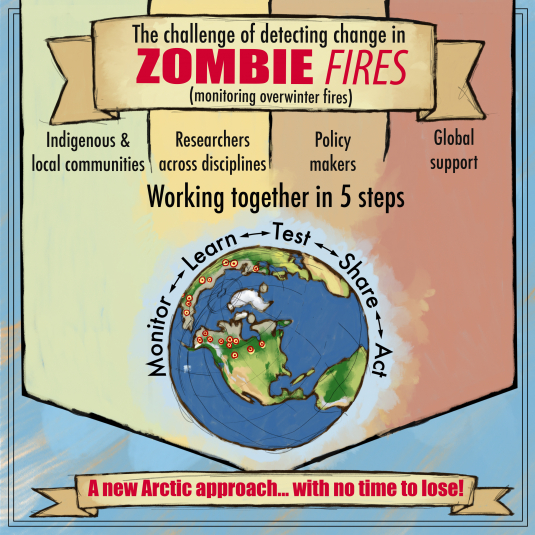Sep 29 2020
New features, such as the burning of fire-resistant vegetation and “zombie fires,” are driving Arctic fires—with serious impacts on the global climate, warned international fire scientists in a commentary recently published in the Nature Geoscience journal.

Image Credit: University of Colorado at Boulder.
The 2020 Arctic wildfire season started a couple of months early and was unparalleled in scope.
It’s not just the amount of burned area that is alarming. There are other trends we noticed in the satellite data that tell us how the Arctic fire regime is changing and what this spells for our climate future.
Dr Merritt Turetsky, Study Co-Author and Fire and Permafrost Ecologist, The Institute of Arctic and Alpine Research, University of Colorado Boulder
The researchers argued that input and know-how of indigenous and other local communities is crucial to understand and control this global problem.
The commentary discovered two novel features of Arctic fires that occurred recently. The first feature is the prevalence of holdover fires, also known as zombie fires. Fire from an earlier growing season can smolder in carbon-rich peat underground throughout the winter, and subsequently re-ignite on the surface once the weather becomes warm in spring.
We know little about the consequences of holdover fires in the Arctic, except that they represent momentum in the climate system and can mean that severe fires in one year set the stage for more burning the next summer.
Dr Merritt Turetsky, Study Co-Author, Fire and Permafrost Ecologist, The Institute of Arctic and Alpine Research, University of Colorado Boulder
The second feature is the latest onset of fire in fire-resistant landscapes. Under the effect of a warmer climate, tundra in the far north is becoming drier and hotter and, as a result, the types of vegetation that were not usually thought of as fuels are beginning to catch fire—moss, grass, sedges, dwarf shrubs, and even surface peats. Wet landscapes, such as marshes, fens, and bogs, are also becoming susceptible to burning.
The researchers have been monitoring fire activity in the Russian Arctic in real time utilizing a range of remote sensing tools and satellites.
Although wildfires on permafrost in Siberia south of the Arctic are not unusual, the researchers found that the 2019 and 2020 periods stood out as extreme in the satellite record for burning that took place well above the Arctic Circle, an area that is generally unknown to support huge wildfires.
Therefore, “Arctic fires are burning earlier and farther north, in landscapes previously thought to be fire resistant,” stated Dr Jessica McCarty, the study’s lead author, geographer, and fire scientist from Miami University.
The impacts of this new fire system could be crucial for the Arctic landscape, the people, and for the global climate. Over 50% of the fires identified in Siberia in 2020 were on the north of the Arctic Circle on permafrost with a high proportion of ground ice.
This kind of permafrost locks in huge amounts of carbon from old biomass. Climate models do not factor in the rapid thaw of these surroundings and the resulting discharge of greenhouse gases, such as methane.
On a more local level, sudden thawing of ice-rich permafrost in wildfires results in craters, pits, floods, and subsidence, and can plunge huge areas under wetlands and lakes. In addition to affecting the lives and livelihoods of Arctic residents, such features are linked with more greenhouse gases, moving from where they are held in soils into the air.
Such extensive changes have serious impacts on the global climate.
“Nearly all of this year's fires inside the Arctic Circle have occurred on continuous permafrost, with over half of these burning on ancient carbon-rich peat soils,” stated Dr Thomas Smith, a fire scientist from the London School of Economics and Political Science and the study’s coauthor. “The record high temperatures and associated fires have the potential to turn this important carbon sink into a carbon source, driving further global heating.”
The consequences of the 2020 Arctic fires highlight an urgent need to further understand a switch in Arctic fire regimes. Novel tools and methods are needed to quantify how fires start and measure the extent of fire.
While remote sensing data and modeling tools can assist, they need to be combined with local, specialized know-how about where legacy carbon is preserved in peats, or permafrost is sensitive to burning, and how surroundings change after wildfires.
The commentary warns that this problem is so crucial to the climate system that it should be considered as a problem of global significance. It summarizes a path forward for interpreting the role of varying fire in the Arctic and also to make sure that research continues to remain focused on policy requirements and the local community.
We need global cooperation, investment, and action in monitoring fires, including learning from Indigenous and local communities how fire is traditionally used. We need new permafrost- and peat-sensitive approaches to wildland fire fighting to save the Arctic—there’s no time to lose.
Dr Merritt Turetsky, Study Co-Author, Fire and Permafrost Ecologist, The Institute of Arctic and Alpine Research, University of Colorado Boulder
Journal Reference
McCarty, J. L., et al. (2020) Arctic fires re-emerging. Nature Geoscience. doi.org/10.1038/s41561-020-00645-5